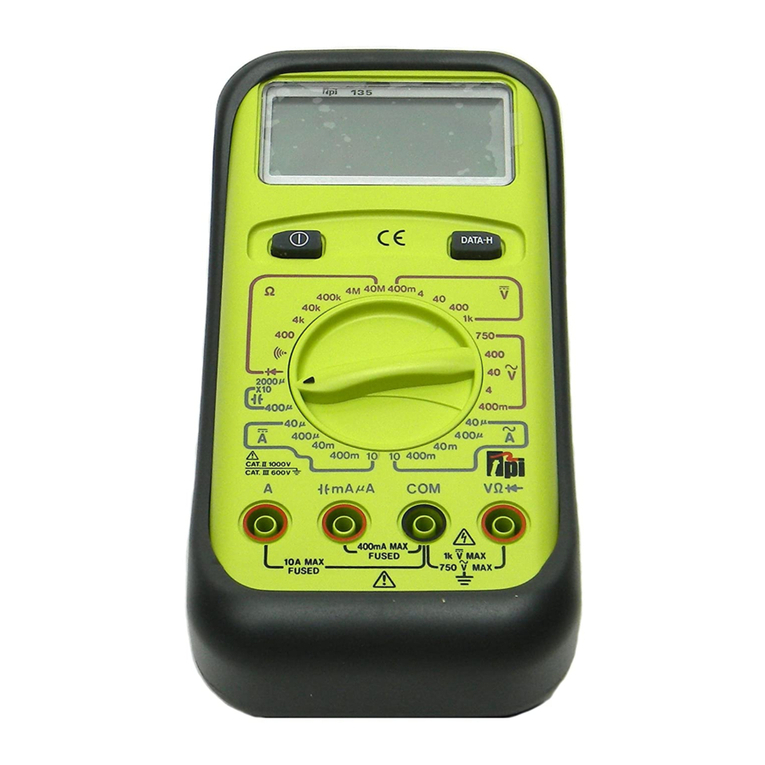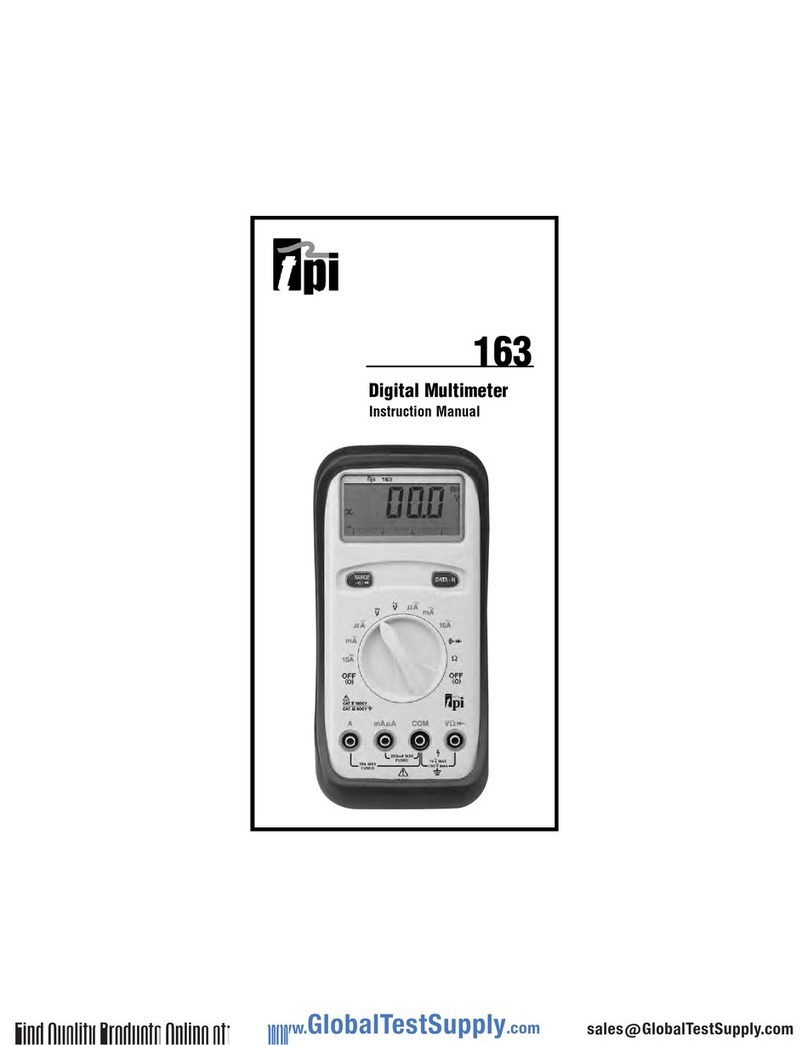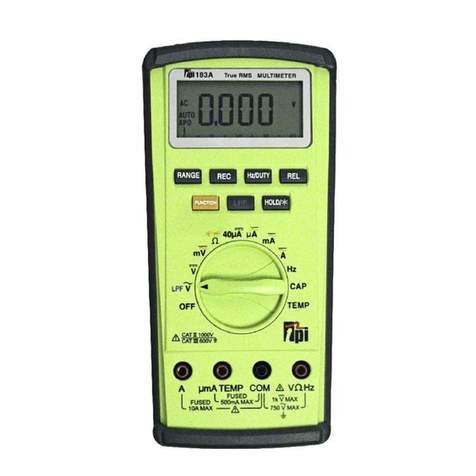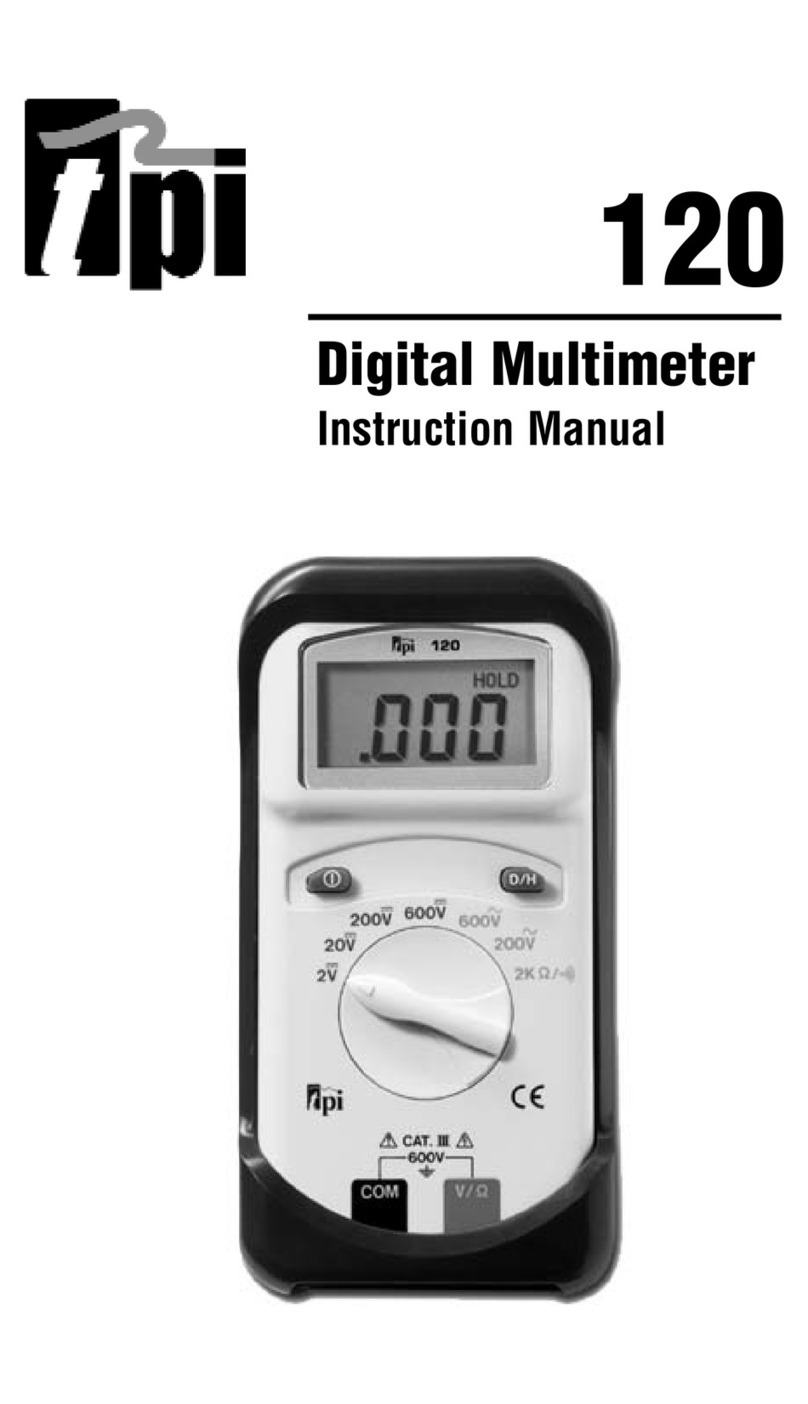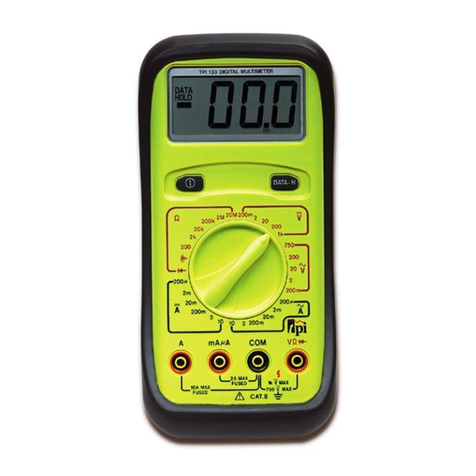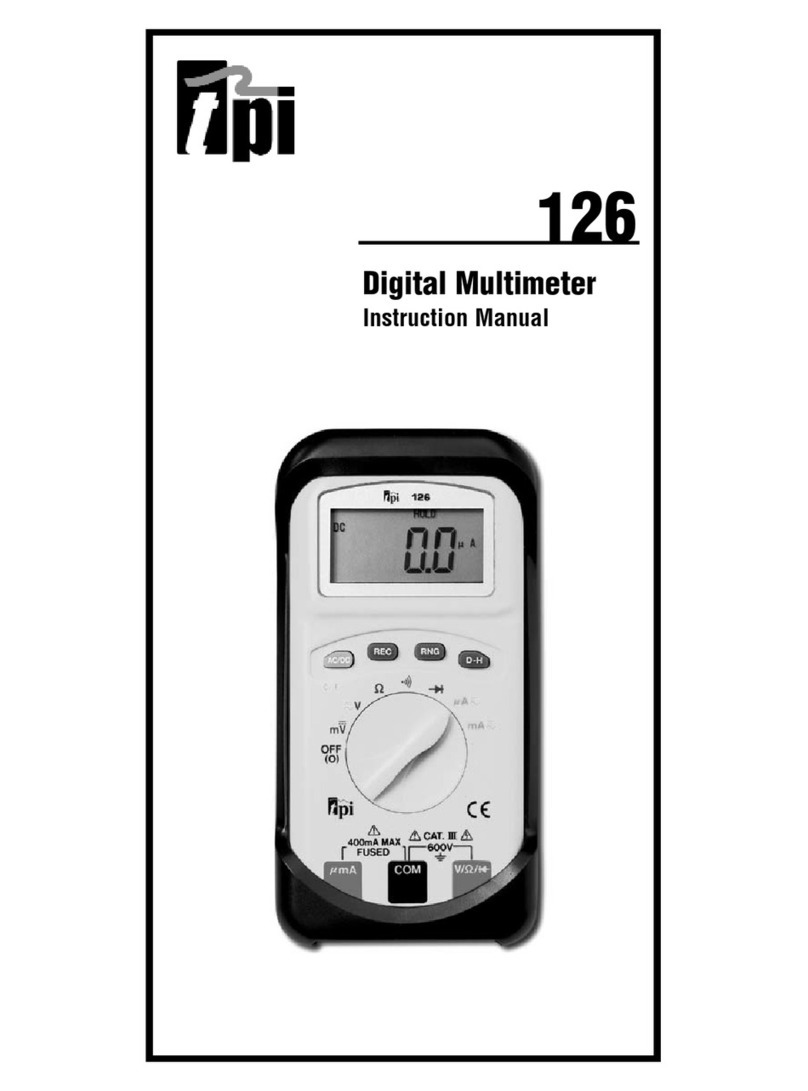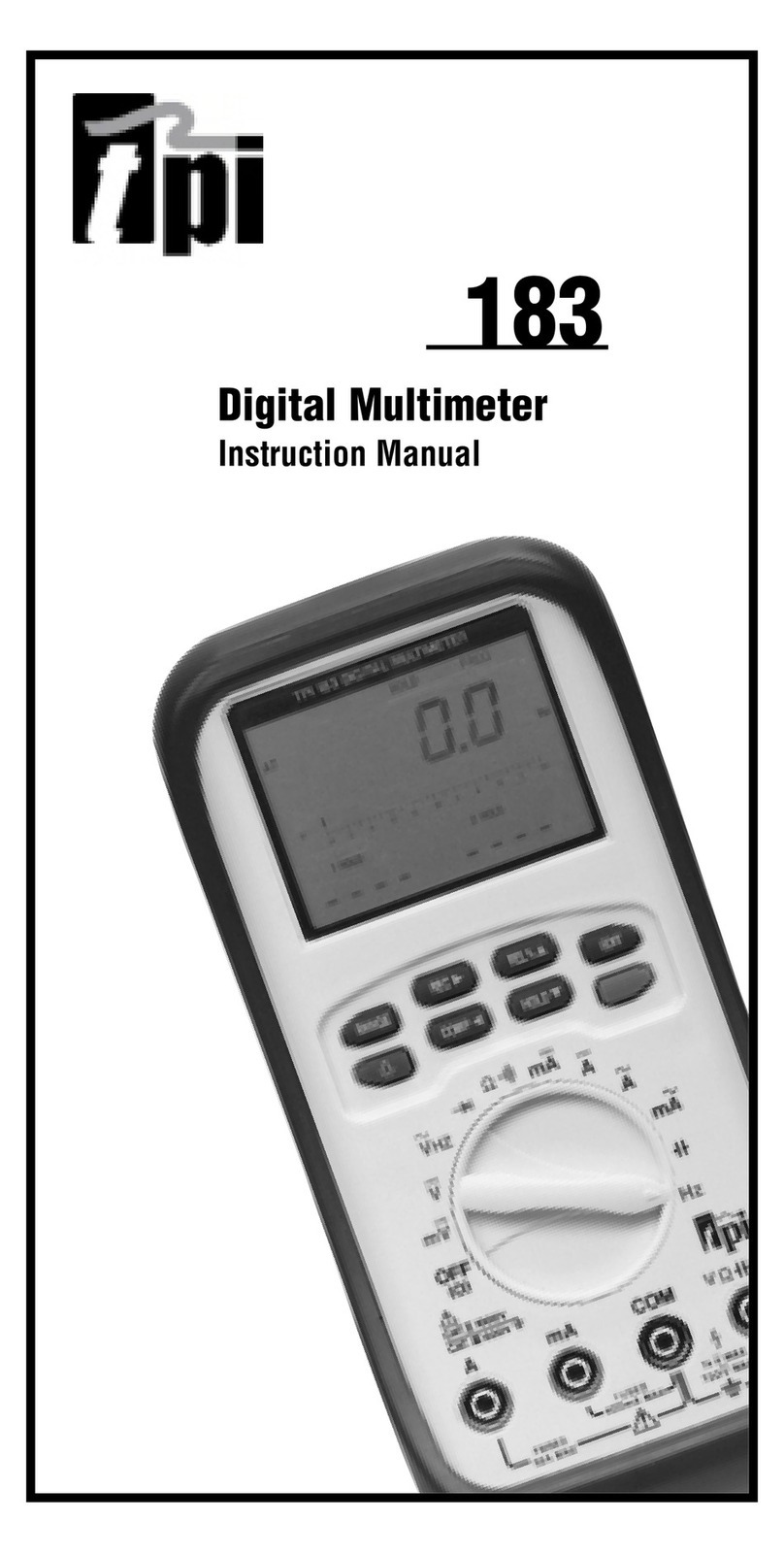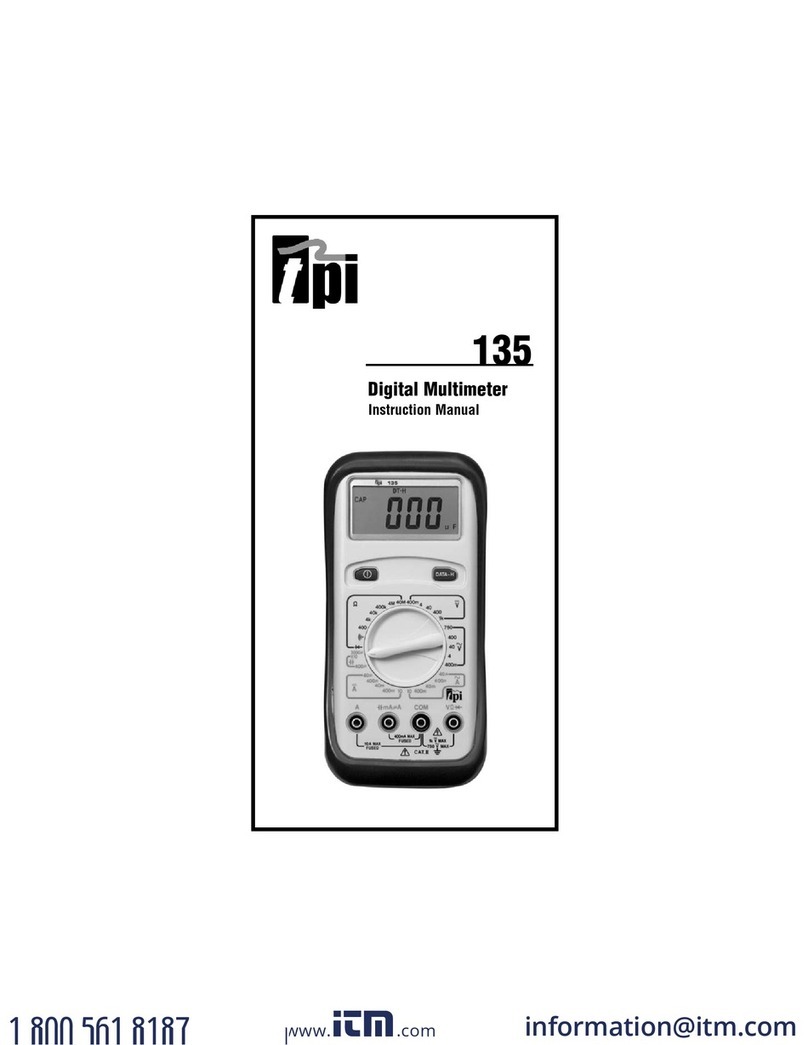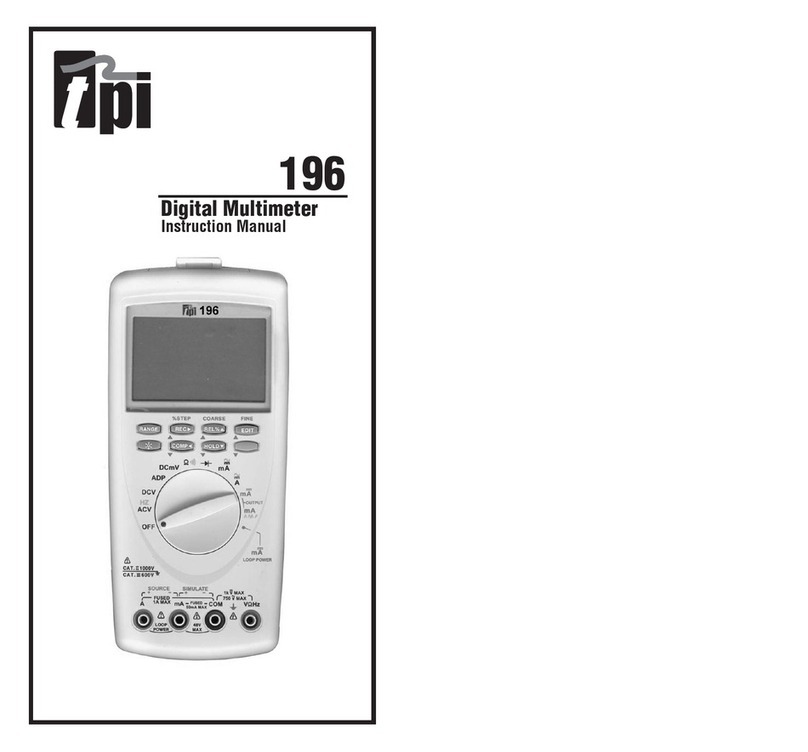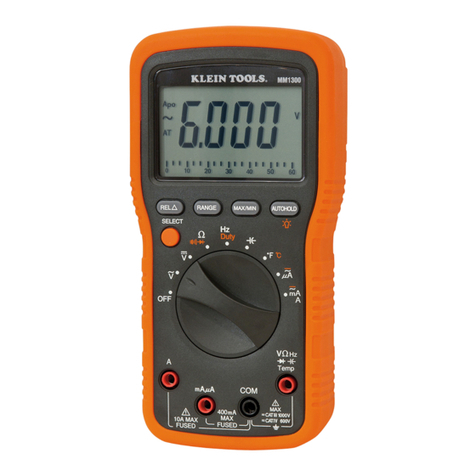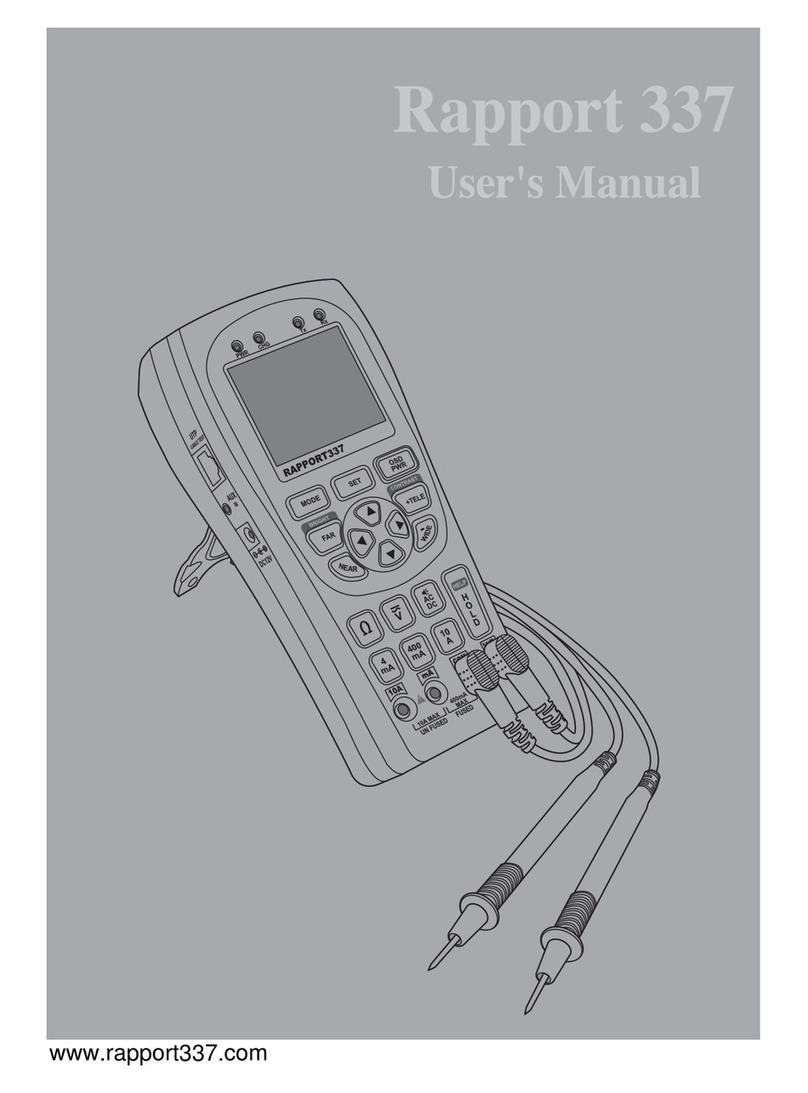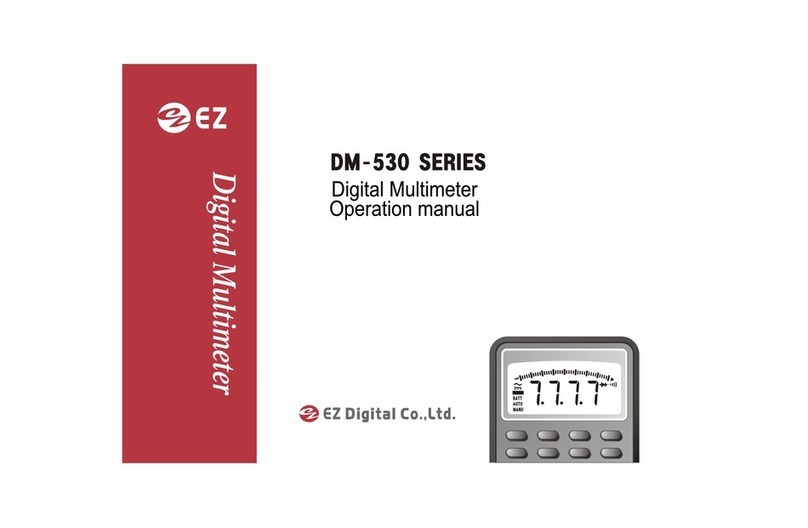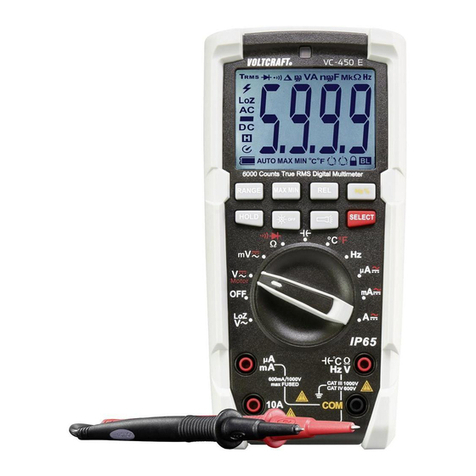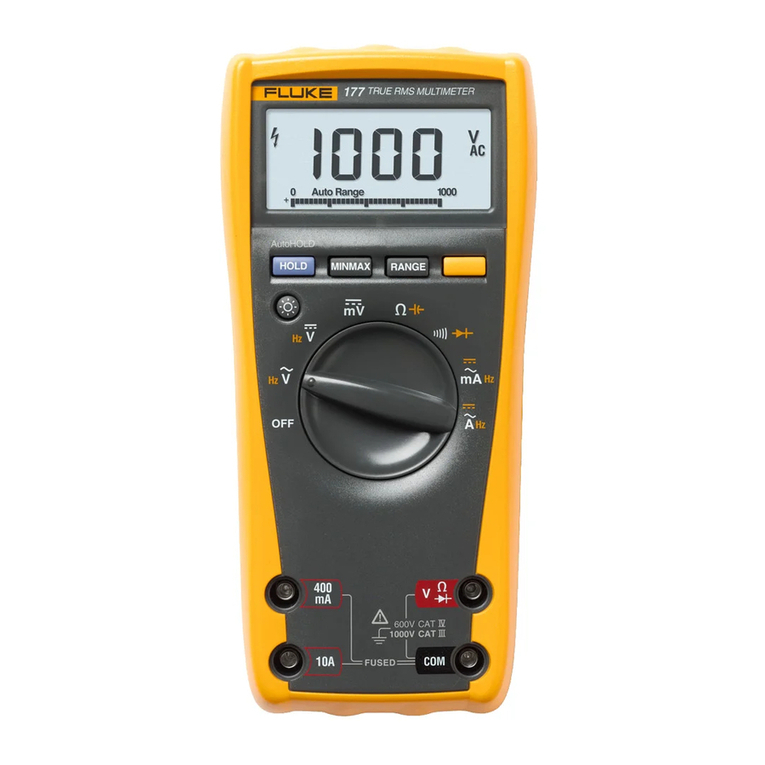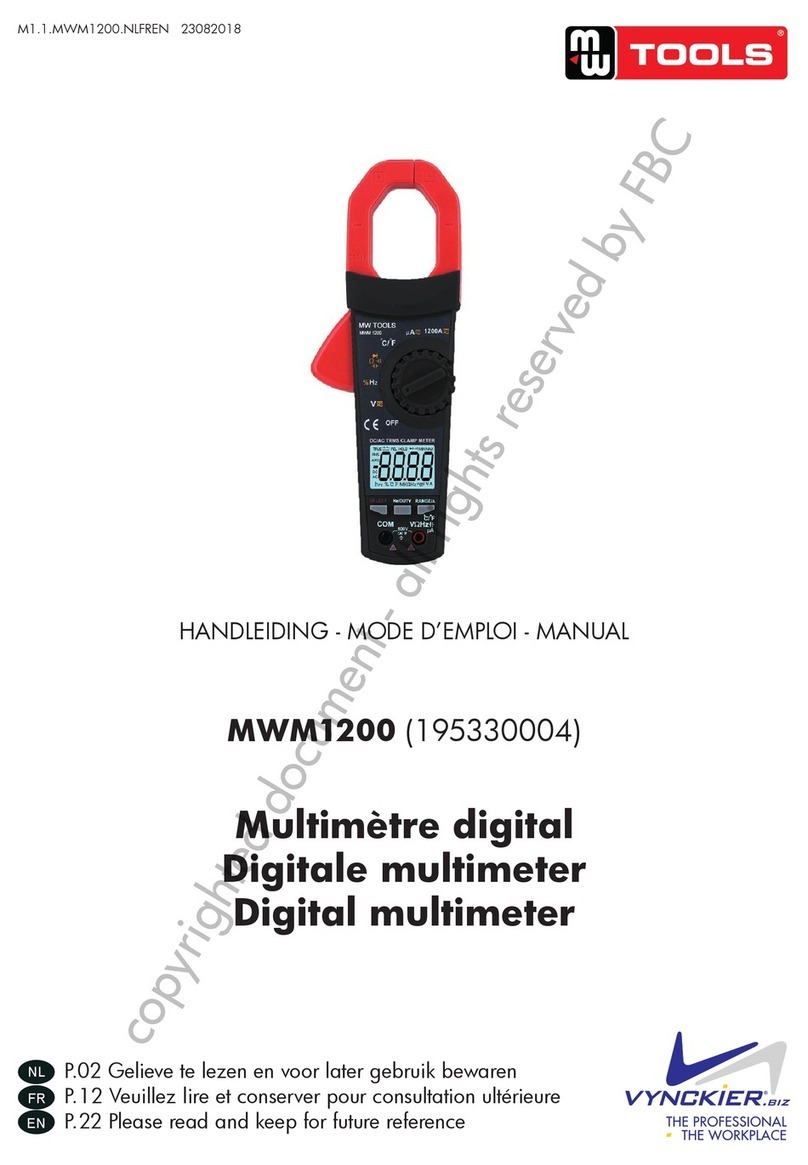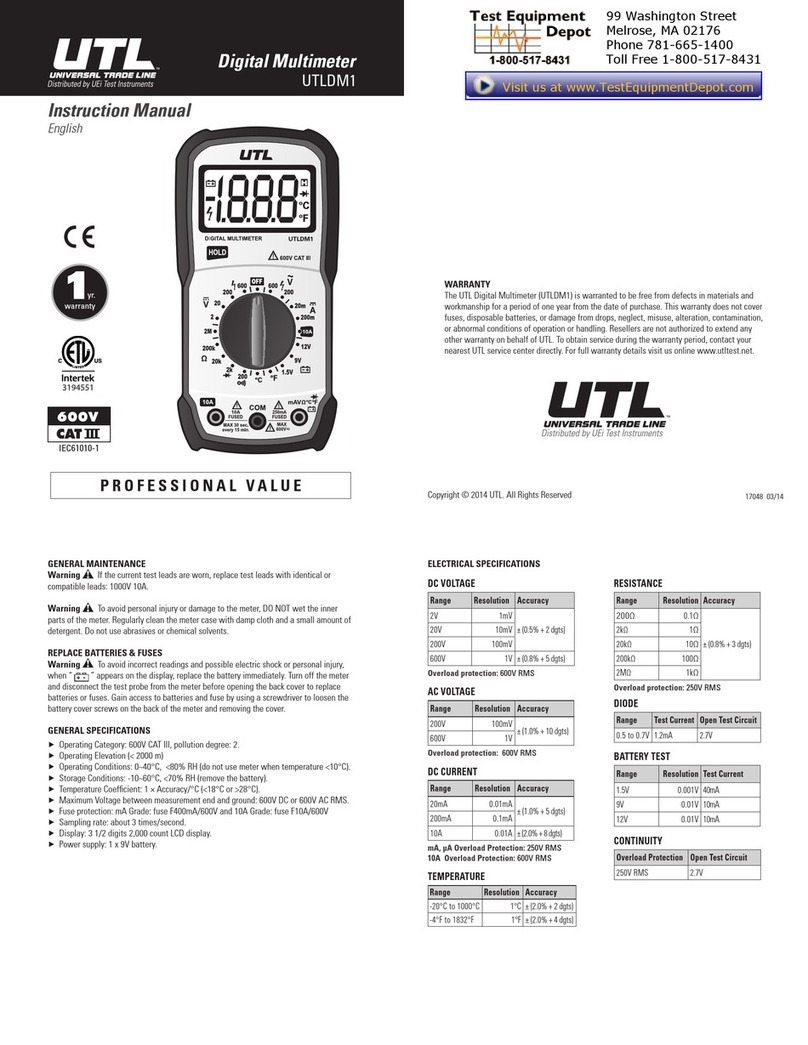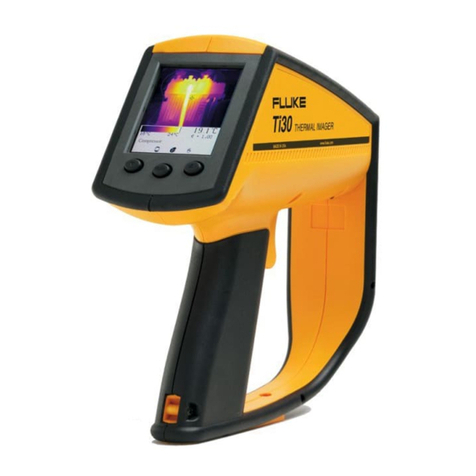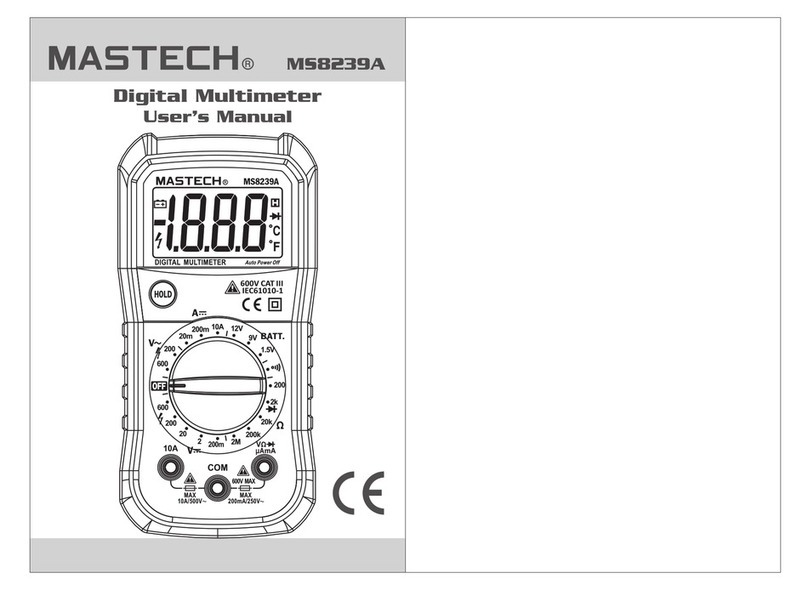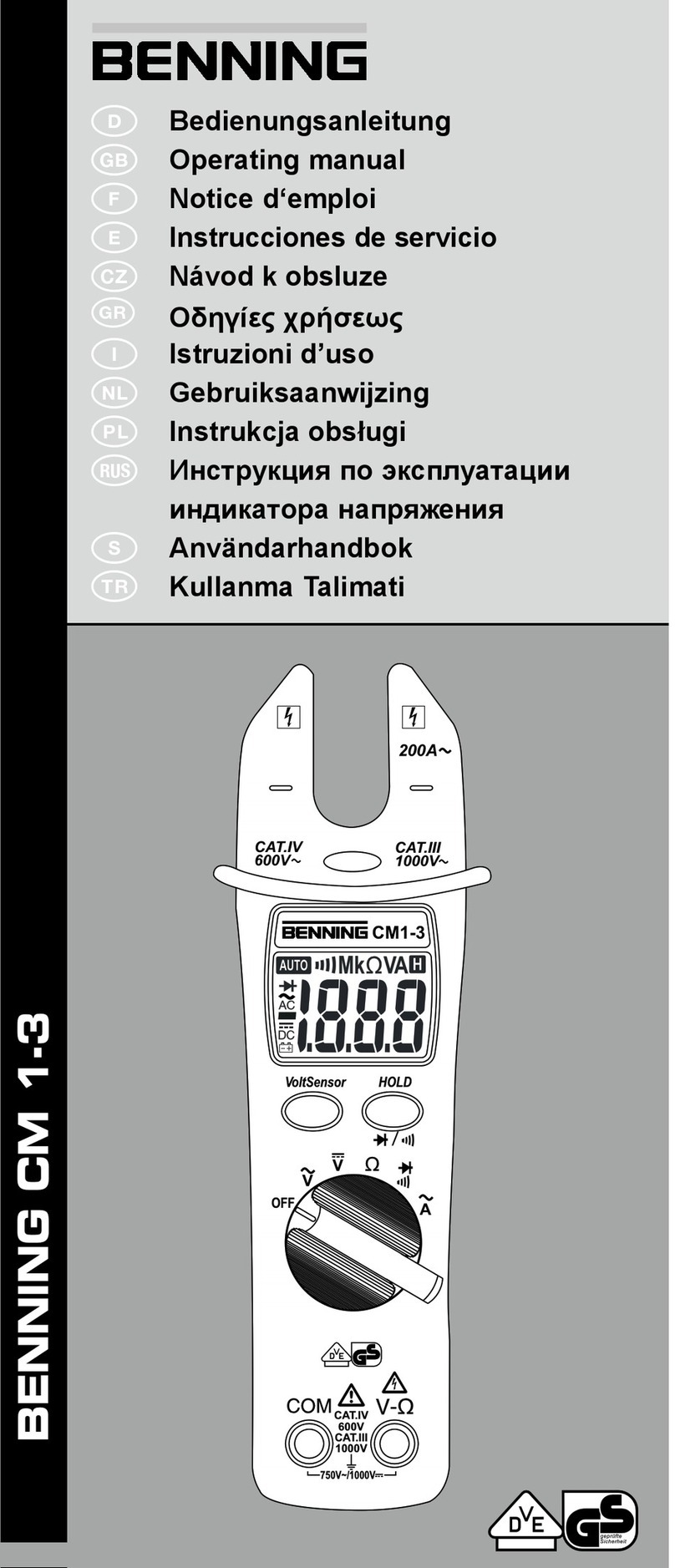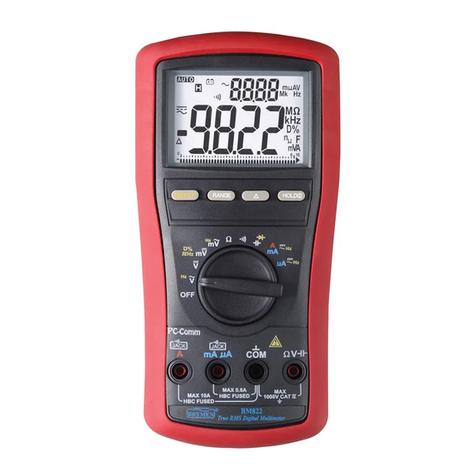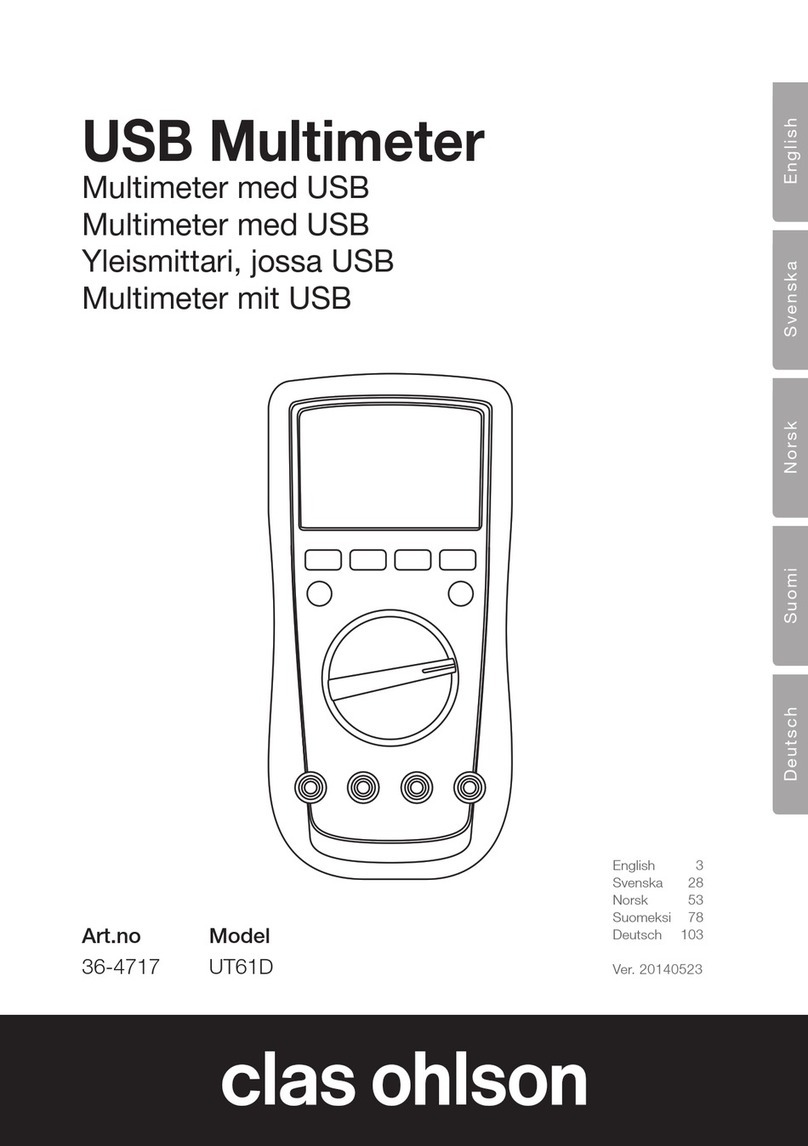TPI 270 User manual

270
Digital Clamp-on
Meter Instruction Manual

A. INTRODUCTION
1. Congratulations!!
Thank you for purchasing TPI products. The 270 is easy
to use and is built to last. It is backed by a 3 year limit-
ed warranty. Please remember to complete and return
your product warranty registration card.
2. Product Description
The slim design 270 is a hand-held, autoranging
clamp-on DMM. Extra large numerals, min/max, capaci-
tance, DC microamps and duty cycle are just a few of the
features of the 270. An affordable choice, the 270 offers
measurements in all basic electrical functions with addi-
tional advanced features like non-contact voltage.
The 270 comes complete with the following accessories:
Carrying Pouch
Test Lead Set
Temperature Probe
Instruction Manual
Battery & Fuse
TABLE OF CONTENTS
A. INTRODUCTION
1. Congratulations ..........................3
2. Product Description....................3
3. Declaration of Conformity ..........4
B. SAFETY CONSIDERATIONS ..............5
C. TECHNICAL DATA
1. Features and Benefits..................6
2. Product Applications ..................7
3. Specifications..............................8
D. MEASUREMENT TECHNIQUES
1. Controls and Functions ............12
2. Step by Step Procedures: ........14
E. OTHER FEATURES ..........................24
F. APPLICATION NOTES ......................29
G. TROUBLE SHOOTING GUIDE ..........34
H. MAINTENANCE ................................35
I. ACCESSORIES ................................36
23

A. INTRODUCTION
1. Congratulations!!
Thank you for purchasing TPI products. The 270 is easy
to use and is built to last. It is backed by a 3 year limit-
ed warranty. Please remember to complete and return
your product warranty registration card.
2. Product Description
The slim design 270 is a hand-held, autoranging
clamp-on DMM. Extra large numerals, min/max, capaci-
tance, DC microamps and duty cycle are just a few of the
features of the 270. An affordable choice, the 270 offers
measurements in all basic electrical functions with addi-
tional advanced features like non-contact voltage.
The 270 comes complete with the following accessories:
Carrying Pouch
Test Lead Set
Temperature Probe
Instruction Manual
Battery & Fuse
TABLE OF CONTENTS
A. INTRODUCTION
1. Congratulations ..........................3
2. Product Description....................3
3. Declaration of Conformity ..........4
B. SAFETY CONSIDERATIONS ..............5
C. TECHNICAL DATA
1. Features and Benefits..................6
2. Product Applications ..................7
3. Specifications..............................8
D. MEASUREMENT TECHNIQUES
1. Controls and Functions ............12
2. Step by Step Procedures: ........14
E. OTHER FEATURES ..........................24
F. APPLICATION NOTES ......................29
G. TROUBLE SHOOTING GUIDE ..........34
H. MAINTENANCE ................................35
I. ACCESSORIES ................................36
23

B. SAFETY CONSIDERATIONS
WARNING: Please follow manufacturers test
procedures whenever possible. Do not attempt to
measure unknown voltages or components until a
complete understanding of the circuit is obtained.
GENERAL GUIDELINES
ALWAYS
• Test the 270 before using it to make sure it is
operating properly.
• Inspect the test leads before using to make sure there
are no breaks or shorts.
• Double check all connections before testing.
• Have someone check on you periodically if
working alone.
• Have a complete understanding of the circuit
being measured.
• Disconnect power to circuit, then connect test leads to
the 270, then to circuit being measured.
NEVER
• Attempt to measure unknown high voltages.
• Attempt to measure DC microamps with the meter in
parallel to the circuit.
• Connect the test leads to a live circuit before
setting up the instrument.
• Touch any exposed metal part of the test lead assembly.
3. EC Declaration of Conformity
This is to certify that TPI Model 270 conforms to the
protection requirements of the council directive
89/336/EEC, in the approximation of laws of the member
states relating to Electromagnetic compatibility and
73/23/EEC. The Low Voltage Directive by application of
the following standards:
EN 50081-1 1992 Emissions Standard
EN 50082-1 1992 Immunity Standard
EN 61010-1 1993 Safety Standard
EN 61010-2-031 1995 Safety Standard
EN 61010-2-032 1995 Safety Standard
To ensure conformity with these standard, this instru-
ment must be operated in accordance with the instruc-
tions and specifications given in this manual.
CAUTION: Even though this instrument complies with
the immunity standards, it’s accuracy can be affected
by strong radio emissions not covered in the above
standards. Sources such as hand-held radio trans-
ceivers, radio and TV transmitters, vehicle radios and
cellular phones generate electromagnetic radiation
that could be induced into the test leads of this instru-
ment. Care should be taken to avoid such situations or
alternatively, check to make sure that the instrument is
not being influence by these emissions.
CAUTION: Please follow manufacturers test proce-
dures whenever possible. Do not attempt to measure
unknown voltages or components until a complete
understanding of the circuit is obtained.
4 5

B. SAFETY CONSIDERATIONS
WARNING: Please follow manufacturers test
procedures whenever possible. Do not attempt to
measure unknown voltages or components until a
complete understanding of the circuit is obtained.
GENERAL GUIDELINES
ALWAYS
• Test the 270 before using it to make sure it is
operating properly.
• Inspect the test leads before using to make sure there
are no breaks or shorts.
• Double check all connections before testing.
• Have someone check on you periodically if
working alone.
• Have a complete understanding of the circuit
being measured.
• Disconnect power to circuit, then connect test leads to
the 270, then to circuit being measured.
NEVER
• Attempt to measure unknown high voltages.
• Attempt to measure DC microamps with the meter in
parallel to the circuit.
• Connect the test leads to a live circuit before
setting up the instrument.
• Touch any exposed metal part of the test lead assembly.
3. EC Declaration of Conformity
This is to certify that TPI Model 270 conforms to the
protection requirements of the council directive
89/336/EEC, in the approximation of laws of the member
states relating to Electromagnetic compatibility and
73/23/EEC. The Low Voltage Directive by application of
the following standards:
EN 50081-1 1992 Emissions Standard
EN 50082-1 1992 Immunity Standard
EN 61010-1 1993 Safety Standard
EN 61010-2-031 1995 Safety Standard
EN 61010-2-032 1995 Safety Standard
To ensure conformity with these standard, this instru-
ment must be operated in accordance with the instruc-
tions and specifications given in this manual.
CAUTION: Even though this instrument complies with
the immunity standards, it’s accuracy can be affected
by strong radio emissions not covered in the above
standards. Sources such as hand-held radio trans-
ceivers, radio and TV transmitters, vehicle radios and
cellular phones generate electromagnetic radiation
that could be induced into the test leads of this instru-
ment. Care should be taken to avoid such situations or
alternatively, check to make sure that the instrument is
not being influence by these emissions.
CAUTION: Please follow manufacturers test proce-
dures whenever possible. Do not attempt to measure
unknown voltages or components until a complete
understanding of the circuit is obtained.
4 5

INTERNATIONAL SYMBOLS
CAUTION: RISK OF ELECTRIC SHOCK
AC (Alternation Current)
DC (Direct Current)
REFER TO INSTRUCTION MANUAL
GROUND
DOUBLE INSULATION
EITHER DC OR AC
C. TECHNICAL DATA
1. Features and Benefits
Agency Meets CE and IEC 1010.
Analog Bar Displays rapidly changing input
Graph signals.
NCV Non-contact voltage detection. Detect
the presence of voltage without con-
tacting the circuit.
P-H Captures min / max peak.
MAX/MIN Records Min/Max readings for all
functions and ranges.
REL Measurements made are displayed
relative to a stored value.
Auto Off Automatically powers off after 30
minutes of inactivity.
2. Product Applications
Perform the following tests and/or measurements with
the 270 and the appropriate function:
HVAC/R
DCmV • Thermocouples in furnaces.
ACA • Heat anticipator current in thermostats.
ACV • Line voltage.
ACV or DCV • Control circuit voltage.
DCmA• Flame safegaurd control current.
OHMS • Compressor winding resistance.
OHMS • Continuity of wiring.
CAP • Motor start and run capacitors.
ACA • Motor and compressor start up current.
Hz • Frequency on controls and line voltage.
TEMP • Air duct temperatures.
ALL • Bar graph to indicate rapid fluctuations.
ELECTRICAL
ACV • Measure line voltage.
ACA • Measure line current.
OHMS • Continuity of circuit breakers.
DCV • Voltage of direct drive DC motors.
ACA • Start up current of motors, relays,
contactors and transformers.
ELECTRONIC
ACV • Measure power supply voltage.
ACA • Measure power supply current.
OHMS • Continuity of circuit breakers and fuses.
6 7

INTERNATIONAL SYMBOLS
CAUTION: RISK OF ELECTRIC SHOCK
AC (Alternation Current)
DC (Direct Current)
REFER TO INSTRUCTION MANUAL
GROUND
DOUBLE INSULATION
EITHER DC OR AC
C. TECHNICAL DATA
1. Features and Benefits
Agency Meets CE and IEC 1010.
Analog Bar Displays rapidly changing input
Graph signals.
NCV Non-contact voltage detection. Detect
the presence of voltage without con-
tacting the circuit.
P-H Captures min / max peak.
MAX/MIN Records Min/Max readings for all
functions and ranges.
REL Measurements made are displayed
relative to a stored value.
Auto Off Automatically powers off after 30
minutes of inactivity.
2. Product Applications
Perform the following tests and/or measurements with
the 270 and the appropriate function:
HVAC/R
DCmV • Thermocouples in furnaces.
ACA • Heat anticipator current in thermostats.
ACV • Line voltage.
ACV or DCV • Control circuit voltage.
DCmA• Flame safegaurd control current.
OHMS • Compressor winding resistance.
OHMS • Continuity of wiring.
CAP • Motor start and run capacitors.
ACA • Motor and compressor start up current.
Hz • Frequency on controls and line voltage.
TEMP • Air duct temperatures.
ALL • Bar graph to indicate rapid fluctuations.
ELECTRICAL
ACV • Measure line voltage.
ACA • Measure line current.
OHMS • Continuity of circuit breakers.
DCV • Voltage of direct drive DC motors.
ACA • Start up current of motors, relays,
contactors and transformers.
ELECTRONIC
ACV • Measure power supply voltage.
ACA • Measure power supply current.
OHMS • Continuity of circuit breakers and fuses.
6 7

9
3. Specifications
IEC 1010 Over Voltage:
CAT II - 1000V
CAT III - 600V
Pollution Degree 2
Temperature for gauranteed accuracy: 23ºC +5ºC
DC VOLTS
Range Res. Accuracy
400mV 0.1mV Impedance:
4V 0.001V +/-(0.5% of reading + 2 digits) 10MW
40V 0.01V Overload Protection:
400V 0.1V 600VDC or AC RMS
600V 1V
(45Hz to 100Hz Frequency Response 400mV Range)
AC VOLTS (45Hz to 450Hz Frequency Response All Other Ranges)
Range Res. Accuracy
400mV 0.1mV +/-(1.2% of reading + 5 digits) Impedance:
4V 0.001V +/-(1.2% of reading + 3 digits) 10MW
40V 0.01V Overload Protection:
400V 0.1V +/-(1.5% of reading + 3 digits) 600VDC or AC RMS
600V 1V
8
DC Microamps
Range Res. Accuracy
40uA 0.01mA+/-(0.8% of reading + 2 digits) Overload Protection:
400uA 0.1mA0.5A / 600V Fusee
*DC microamps are measured with the test leads in series with
the circuit under test.
OHM (Resistance, W)
Range Res. Accuracy
400W0.1W±(1% of reading +5 digits)
4kW0.001kW±(1% of reading +2 digits) Overload Protection:
40kW0.01kW250VDC or AC RMS
400kW0.1kW
4MW0.001MW±(3% of reading +5 digits)
40MW0.01MW ±(3% of reading +10 digits)
Frequency (Hz)
Range Res. Accuracy
4.000kHz 0.001kHz ±(1% of reading +2 digits)
40.00kHz 0.01kHz
400.0kHz 0.1kHz Overload Protection:
4.000MHz 0.001MHz 250VDC or AC RMS
40.00MHz 0.01MHz
400.0MHz 0.1MHz
UL 3111 Pending
(45Hz to 100Hz Frequency Response 200A to 400A)
AC AMPS (45Hz to 450Hz Frequency Response Below 200A)
Range Res. Accuracy
40A 0.01A +/-(3.0% of reading + 5 digits)
400A 0.1A e
Warning: Use only correct type and overvoltage
category rated test leads. Remove the
temperature probe when using the test
leads or amp clamp.

9
3. Specifications
IEC 1010 Over Voltage:
CAT II - 1000V
CAT III - 600V
Pollution Degree 2
Temperature for gauranteed accuracy: 23ºC +5ºC
DC VOLTS
Range Res. Accuracy
400mV 0.1mV Impedance:
4V 0.001V +/-(0.5% of reading + 2 digits) 10MW
40V 0.01V Overload Protection:
400V 0.1V 600VDC or AC RMS
600V 1V
(45Hz to 100Hz Frequency Response 400mV Range)
AC VOLTS (45Hz to 450Hz Frequency Response All Other Ranges)
Range Res. Accuracy
400mV 0.1mV +/-(1.2% of reading + 5 digits) Impedance:
4V 0.001V +/-(1.2% of reading + 3 digits) 10MW
40V 0.01V Overload Protection:
400V 0.1V +/-(1.5% of reading + 3 digits) 600VDC or AC RMS
600V 1V
8
DC Microamps
Range Res. Accuracy
40uA 0.01mA+/-(0.8% of reading + 2 digits) Overload Protection:
400uA 0.1mA0.5A / 600V Fusee
*DC microamps are measured with the test leads in series with
the circuit under test.
OHM (Resistance, W)
Range Res. Accuracy
400W0.1W±(1% of reading +5 digits)
4kW0.001kW±(1% of reading +2 digits) Overload Protection:
40kW0.01kW250VDC or AC RMS
400kW0.1kW
4MW0.001MW±(3% of reading +5 digits)
40MW0.01MW ±(3% of reading +10 digits)
Frequency (Hz)
Range Res. Accuracy
4.000kHz 0.001kHz ±(1% of reading +2 digits)
40.00kHz 0.01kHz
400.0kHz 0.1kHz Overload Protection:
4.000MHz 0.001MHz 250VDC or AC RMS
40.00MHz 0.01MHz
400.0MHz 0.1MHz
UL 3111 Pending
(45Hz to 100Hz Frequency Response 200A to 400A)
AC AMPS (45Hz to 450Hz Frequency Response Below 200A)
Range Res. Accuracy
40A 0.01A +/-(3.0% of reading + 5 digits)
400A 0.1A e
Warning: Use only correct type and overvoltage
category rated test leads. Remove the
temperature probe when using the test
leads or amp clamp.

Diode Test
Test Current Over Load Protection
1.5mA MAX 250 V DC or AC RMS
Continuity Buzzer
Test Voltage Threshold Over Load Protection
3V <35W250 V DC or AC RMS
Non-Contact Voltage (NCV)
Detection Range: 24VAC and above
Temperature (K-Type thermocouple)
Range Res. Accuracy
-40ºF to 399.9ºF 0.1ºF +(1ºF) 32.0ºF to 120.0ºF
+(1%+1.5ºF) -4.0ºF to 31.9ºF
+(1%+1.5ºF) -120.1ºF to 399.9ºF
+(2%+4ºF) -40.0ºF to -3.9ºF
-40ºF to 1000ºF 1ºF +(2ºF) 32.0ºF to 120ºF
+(1%+2ºF) -3ºF to 749ºF
+(2%+1.5ºF) 750ºF to 1000ºF
+(2%+4ºF) -40ºF to -4ºF
Overload Protection: 60VDC or 30VAC RMS
**Celsius version of the 270 is available
11
10
Capacitance
Range Res. Accuracy
4nF 0.001nF ±(1% of reading +2 digits)
40nF 0.01nF
400nF 0.1nF Overload Protection:
4mF 0.001mF500VDC or AC RMS
40mF 0.01mF
400mF 0.1uF
4mF 0.001mF
40mF 0.01mF ±(3% of reading +5 digits)
nF= nanofarad, mF= microfarad, mF= millifarad
General
Max Voltage between any 600V
input and ground
Fuse Protection (mmA range) 0.5A/600V
Display Type 4000 Count 41 seg. bargraph
Operating Temperature 32ºF to 104ºF (0ºC to 40ºC)
Storage Temperature 14ºF to 122ºF (-10ºC to 50ºC)
Relative Humidity 80% non-condensing
Power Supply 9V (MN1604)
Battery Life 80 hrs. typical
Size (H x L x W) 32.5mm x 255mm x 65mm
(1.3in x 10in x 2.5in)
Weight 363g (0.8lbs)
Warning: Use only correct type and overvoltage
category rated test leads. Remove the
temperature probe when using the test
leads or amp clamp.
Warning: Use only correct type and overvoltage
category rated test leads. Remove the
temperature probe when using the test
leads or amp clamp.

Diode Test
Test Current Over Load Protection
1.5mA MAX 250 V DC or AC RMS
Continuity Buzzer
Test Voltage Threshold Over Load Protection
3V <35W250 V DC or AC RMS
Non-Contact Voltage (NCV)
Detection Range: 24VAC and above
Temperature (K-Type thermocouple)
Range Res. Accuracy
-40ºF to 399.9ºF 0.1ºF +(1ºF) 32.0ºF to 120.0ºF
+(1%+1.5ºF) -4.0ºF to 31.9ºF
+(1%+1.5ºF) -120.1ºF to 399.9ºF
+(2%+4ºF) -40.0ºF to -3.9ºF
-40ºF to 1000ºF 1ºF +(2ºF) 32.0ºF to 120ºF
+(1%+2ºF) -3ºF to 749ºF
+(2%+1.5ºF) 750ºF to 1000ºF
+(2%+4ºF) -40ºF to -4ºF
Overload Protection: 60VDC or 30VAC RMS
**Celsius version of the 270 is available
11
10
Capacitance
Range Res. Accuracy
4nF 0.001nF ±(1% of reading +2 digits)
40nF 0.01nF
400nF 0.1nF Overload Protection:
4mF 0.001mF500VDC or AC RMS
40mF 0.01mF
400mF 0.1uF
4mF 0.001mF
40mF 0.01mF ±(3% of reading +5 digits)
nF= nanofarad, mF= microfarad, mF= millifarad
General
Max Voltage between any 600V
input and ground
Fuse Protection (mmA range) 0.5A/600V
Display Type 4000 Count 41 seg. bargraph
Operating Temperature 32ºF to 104ºF (0ºC to 40ºC)
Storage Temperature 14ºF to 122ºF (-10ºC to 50ºC)
Relative Humidity 80% non-condensing
Power Supply 9V (MN1604)
Battery Life 80 hrs. typical
Size (H x L x W) 32.5mm x 255mm x 65mm
(1.3in x 10in x 2.5in)
Weight 363g (0.8lbs)
Warning: Use only correct type and overvoltage
category rated test leads. Remove the
temperature probe when using the test
leads or amp clamp.
Warning: Use only correct type and overvoltage
category rated test leads. Remove the
temperature probe when using the test
leads or amp clamp.

13
12
1. Controls and Functions: (cont.)
Rotary Switch
OFF Turns the 270 completely off.
VUsed to measure DC volts.
VUsed to measure AC volts.
WUsed to measure resistance.
Used to measure continuity.
Selects diode test function.
Selects capacitance test function.
Hz Selects frequency test function.
mASelects DC microamp function.
Used to measure AC amperage.
TEMP Selects the temperature function.
Input Jacks
COM Black test lead connection for all
tests except temperature, non-con-
tact voltage and AC Amps.
V/W/mARed test lead connection for all
tests except temperature, non-con-
tact voltage and AC Amps.
D. MEASUREMENT TECHNIQUES
1. Controls and Functions:
Push Buttons
REL Activates Relative mode. Press
and hold for 2 seconds to deacti-
vate.
D-H Holds the reading on the display
until the button is pushed a
second time.
R-H Activates manual ranging. Press
and hold for 2 seconds to return
to auto ranging.
MAX MIN Activates record mode. Press to
cycle between maximum and min-
imum recorded reading. Press and
hold for 2 seconds to return to
normal mode.
P-H Activates peak hold mode. Used to
capture in-rush current.
NCV Activates the non-contact voltage
detection feature. Press and hold
while holding the jaw close to
electrical wires.

13
12
1. Controls and Functions: (cont.)
Rotary Switch
OFF Turns the 270 completely off.
VUsed to measure DC volts.
VUsed to measure AC volts.
WUsed to measure resistance.
Used to measure continuity.
Selects diode test function.
Selects capacitance test function.
Hz Selects frequency test function.
mASelects DC microamp function.
Used to measure AC amperage.
TEMP Selects the temperature function.
Input Jacks
COM Black test lead connection for all
tests except temperature, non-con-
tact voltage and AC Amps.
V/W/mARed test lead connection for all
tests except temperature, non-con-
tact voltage and AC Amps.
D. MEASUREMENT TECHNIQUES
1. Controls and Functions:
Push Buttons
REL Activates Relative mode. Press
and hold for 2 seconds to deacti-
vate.
D-H Holds the reading on the display
until the button is pushed a
second time.
R-H Activates manual ranging. Press
and hold for 2 seconds to return
to auto ranging.
MAX MIN Activates record mode. Press to
cycle between maximum and min-
imum recorded reading. Press and
hold for 2 seconds to return to
normal mode.
P-H Activates peak hold mode. Used to
capture in-rush current.
NCV Activates the non-contact voltage
detection feature. Press and hold
while holding the jaw close to
electrical wires.

Measuring AC Voltage
WARNING!
Do not attempt to make a voltage measurement of more than
600V or of a voltage level that is unknown. Make sure the tem-
perature probe is NOT plugged in during this test.
Instrument set-up:
FUNC. BLACK RED MIN MAX
TEST LEAD TEST LEAD READING READING
COM V/W0.1mV 600V
Measurement Procedure:
1. Disconnect power to circuit to be measured.
2. Plug black test lead into the COM input jack.
3 Plug red test lead into the V/Winput jack.
4. Set rotary switch to the V range.
5. Connect test leads to circuit to be measured.
6. Reconnect power to circuit to be measured.
7. Read the voltage on the 270.
Optional Modes
(See Other Features Section)
•D-H: Freezes the reading on the LCD.
•MAX/MIN: Records minimum and maximum measurements.
•P-H: Displays peak voltage.
2. Step by Step Procedures:
Measuring DC Voltage
WARNING!
Do not attempt to make a voltage measurement of more
than 600V or of a voltage level that is unknown. Make sure
the temperature probe is NOT plugged in during this test.
Instrument set-up:
FUNC. BLACK RED MIN MAXI
TEST LEAD TEST LEAD READING READING
COM V/W0.1mV 600V
Measurement Procedure:
1. Disconnect power to circuit to be measured.
2. Plug black test lead into the COM input jack.
3 Plug red test lead into the V/Winput jack.
4. Set rotary switch to the V range.
5. Connect test leads to circuit to be measured.
6. Reconnect power to circuit to be measured.
7. Read the voltage on the 270.
Optional Modes
(See Other Features Section)
•D-H: Freezes the reading on the LCD.
•MAX/MIN: Records minimum a.
•P-H: Displays peak voltage.
15
14

Measuring AC Voltage
WARNING!
Do not attempt to make a voltage measurement of more than
600V or of a voltage level that is unknown. Make sure the tem-
perature probe is NOT plugged in during this test.
Instrument set-up:
FUNC. BLACK RED MIN MAX
TEST LEAD TEST LEAD READING READING
COM V/W0.1mV 600V
Measurement Procedure:
1. Disconnect power to circuit to be measured.
2. Plug black test lead into the COM input jack.
3 Plug red test lead into the V/Winput jack.
4. Set rotary switch to the V range.
5. Connect test leads to circuit to be measured.
6. Reconnect power to circuit to be measured.
7. Read the voltage on the 270.
Optional Modes
(See Other Features Section)
•D-H: Freezes the reading on the LCD.
•MAX/MIN: Records minimum and maximum measurements.
•P-H: Displays peak voltage.
2. Step by Step Procedures:
Measuring DC Voltage
WARNING!
Do not attempt to make a voltage measurement of more
than 600V or of a voltage level that is unknown. Make sure
the temperature probe is NOT plugged in during this test.
Instrument set-up:
FUNC. BLACK RED MIN MAXI
TEST LEAD TEST LEAD READING READING
COM V/W0.1mV 600V
Measurement Procedure:
1. Disconnect power to circuit to be measured.
2. Plug black test lead into the COM input jack.
3 Plug red test lead into the V/Winput jack.
4. Set rotary switch to the V range.
5. Connect test leads to circuit to be measured.
6. Reconnect power to circuit to be measured.
7. Read the voltage on the 270.
Optional Modes
(See Other Features Section)
•D-H: Freezes the reading on the LCD.
•MAX/MIN: Records minimum a.
•P-H: Displays peak voltage.
15
14

Measuring AC Amperage
CAUTION!
Do not attempt to make a current measurement with the
test leads. The 270 measures the current by clamping the
jaw around one conductor (wire). Clamping around more
than one wire will result in erroneous readings. Make sure
the temperature probe is NOT plugged in during this test.
Instrument set-up:
FUNC. BLACK RED MIN MAX
TEST LEAD TEST LEAD READING READING
NOT USED NOT USED 0.01A 400A
Measurement Procedure:
1. Disconnect power to circuit to be measured.
2. Set rotary switch to function.
3. Clamp the jaws around one conductor of the circuit to
be measured. For best results, center the wire in the
jaw.
4. Reconnect power to circuit to be measured.
5. Read the current on the 270.
Optional Modes
(See Other Features Section)
•D-H: Freezes the reading on the LCD.
•MAX/MIN: Records minimum and maximum measure-
ments
•P-H: Displays peak amperage.
17
16
Measuring Resistance
WARNING!
Do not attempt to make resistance measurements with circuit
energized. For best results, remove the resistor completely from
circuit before attempting to measure it. Make sure the tempera-
ture probe is NOT plugged in during this test.
NOTE:
To make accurate low ohm measurements, short the ends of the
test leads together and press the REL button to store the reading.
This will deduct the stored value from subsequent measurements
eliminating the test lead resistance from the reading.
Instrument set-up:
FUNC. BLACK RED MIN MAX
TEST LEAD TEST LEAD READING READING
WCOM V/W0.1W40.00MW
Measurement Procedure:
1. Disconnect power to circuit to be measured.
2. Plug black test lead into the COM input jack.
3. Plug red test lead into V/Winput jack.
4. Set the rotary switch to the Wfunction.
5. Connect test leads to circuit to be measured.
6. Read the resistance value on the 270.
Optional Modes
(See Other Features Section)
•D-H: Freezes the reading on the LCD.

Measuring AC Amperage
CAUTION!
Do not attempt to make a current measurement with the
test leads. The 270 measures the current by clamping the
jaw around one conductor (wire). Clamping around more
than one wire will result in erroneous readings. Make sure
the temperature probe is NOT plugged in during this test.
Instrument set-up:
FUNC. BLACK RED MIN MAX
TEST LEAD TEST LEAD READING READING
NOT USED NOT USED 0.01A 400A
Measurement Procedure:
1. Disconnect power to circuit to be measured.
2. Set rotary switch to function.
3. Clamp the jaws around one conductor of the circuit to
be measured. For best results, center the wire in the
jaw.
4. Reconnect power to circuit to be measured.
5. Read the current on the 270.
Optional Modes
(See Other Features Section)
•D-H: Freezes the reading on the LCD.
•MAX/MIN: Records minimum and maximum measure-
ments
•P-H: Displays peak amperage.
17
16
Measuring Resistance
WARNING!
Do not attempt to make resistance measurements with circuit
energized. For best results, remove the resistor completely from
circuit before attempting to measure it. Make sure the tempera-
ture probe is NOT plugged in during this test.
NOTE:
To make accurate low ohm measurements, short the ends of the
test leads together and press the REL button to store the reading.
This will deduct the stored value from subsequent measurements
eliminating the test lead resistance from the reading.
Instrument set-up:
FUNC. BLACK RED MIN MAX
TEST LEAD TEST LEAD READING READING
WCOM V/W0.1W40.00MW
Measurement Procedure:
1. Disconnect power to circuit to be measured.
2. Plug black test lead into the COM input jack.
3. Plug red test lead into V/Winput jack.
4. Set the rotary switch to the Wfunction.
5. Connect test leads to circuit to be measured.
6. Read the resistance value on the 270.
Optional Modes
(See Other Features Section)
•D-H: Freezes the reading on the LCD.

Measuring Diodes
WARNING!
Do not attempt to make diode measurements with the circuit
energized. For accurate tests, remove the diode completely
from the circuit prior to measuring it. Make sure the tempera-
ture probe is NOT plugged in during this test.
Instrument set-up:
FUNC. BLACK RED
TEST LEAD TEST LEAD
COM V/W/mA
Measurement Procedure:
1. Disconnect power to circuit to be measured.
2. Plug black test lead into the COM input jack.
3. Plug red test lead into V/Winput jack.
4. Set the rotary switch to the
5. Connect the black test lead to the banded end of the diode
(cathode) and the red test lead to the non-banded end of
the diode (anode).
6. For a good diode, the reading on the display should be
between 0.5V and 0.8V. The reading will be lower for a
germanium diode.
7. Reverse the leads on the diode.
8. For a good diode, the reading on the display should be OL
(overload).
Optional Modes
(See Other Features Section)
•D-H: Freezes the reading on the LCD.
19
18
position.
Measuring Continuity
WARNING!
Do not attempt to make continuity measurements with circuit
energized. Make sure the temperature probe is NOT plugged
in during this test.
Instrument set-up:
FUNC. BLACK RED
TEST LEAD TEST LEAD
COM V/W
Measurement Procedure:
1. Disconnect power to circuit to be measured.
2. Plug black test lead into the COM input jack.
3. Plug red test lead into V/Winput jack.
4. Set the rotary switch to the position.
5. Connect test leads to circuit to be measured.
6. The 270 will beep and the LED will illuminate at
resistances of 35Wor lower.
Optional Modes
(See Other Features Section)
•D-H: Freezes the reading on the LCD.

Measuring Diodes
WARNING!
Do not attempt to make diode measurements with the circuit
energized. For accurate tests, remove the diode completely
from the circuit prior to measuring it. Make sure the tempera-
ture probe is NOT plugged in during this test.
Instrument set-up:
FUNC. BLACK RED
TEST LEAD TEST LEAD
COM V/W/mA
Measurement Procedure:
1. Disconnect power to circuit to be measured.
2. Plug black test lead into the COM input jack.
3. Plug red test lead into V/Winput jack.
4. Set the rotary switch to the
5. Connect the black test lead to the banded end of the diode
(cathode) and the red test lead to the non-banded end of
the diode (anode).
6. For a good diode, the reading on the display should be
between 0.5V and 0.8V. The reading will be lower for a
germanium diode.
7. Reverse the leads on the diode.
8. For a good diode, the reading on the display should be OL
(overload).
Optional Modes
(See Other Features Section)
•D-H: Freezes the reading on the LCD.
19
18
position.
Measuring Continuity
WARNING!
Do not attempt to make continuity measurements with circuit
energized. Make sure the temperature probe is NOT plugged
in during this test.
Instrument set-up:
FUNC. BLACK RED
TEST LEAD TEST LEAD
COM V/W
Measurement Procedure:
1. Disconnect power to circuit to be measured.
2. Plug black test lead into the COM input jack.
3. Plug red test lead into V/Winput jack.
4. Set the rotary switch to the position.
5. Connect test leads to circuit to be measured.
6. The 270 will beep and the LED will illuminate at
resistances of 35Wor lower.
Optional Modes
(See Other Features Section)
•D-H: Freezes the reading on the LCD.

Measuring Capacitance
WARNING!
All capacitance measurements are to be made on de-energized
circuits with all capacitors discharged only. Failure to de-energize
and discharge capacitors prior to measuring them could result in
instrument damage and/or personal injury. Make sure the temper-
ature probe is NOT plugged in during this test.
Instrument set-up:
FUNC. BLACK RED
TEST LEAD TEST LEAD
COM V/W/mA
Measurement Procedure:
1. Disconnect power to circuit to be measured.
2. Plug black test lead into the COM input jack.
3. Plug red test lead into V/Winput jack.
4. Set the rotary switch to the
5. Remove the capacitor from the circuit and discharge it.
6. Connect test leads to the capacitor to be measured.
Observe polarity on polarity sensitive capacitors.
7. Read the capacitor value on the LCD.
Optional Modes
(See Other Features Section)
•D-H: Freezes the reading on the LCD.
21
20
Measuring Frequency
WARNING!
Never attempt a frequency measurement with a voltage source
greater than 500V. Determine the voltage of any unknown fre-
quency source before connecting the instrument in frequency
mode. Make sure the temperature probe is NOT plugged in
during this test.
Instrument set-up:
FUNC. BLACK RED
TEST LEAD TEST LEAD
Hz COM V/W/mA
Measurement Procedure:
1. Disconnect power to the circuit to be measured.
2. Plug black test lead into the COM input jack.
3. Plug red test lead into V/Winput jack.
4. Set the rotary switch to the Hz position.
5. Reconnect power to the circuit to be measured.
6. Read the frequency on the LCD.
Optional Modes
(See Other Features Section)
•D-H: Freezes the reading on the LCD.
•MAX/MIN: Records minimum and maximum measure-
ments
position.
Table of contents
Other TPI Multimeter manuals

